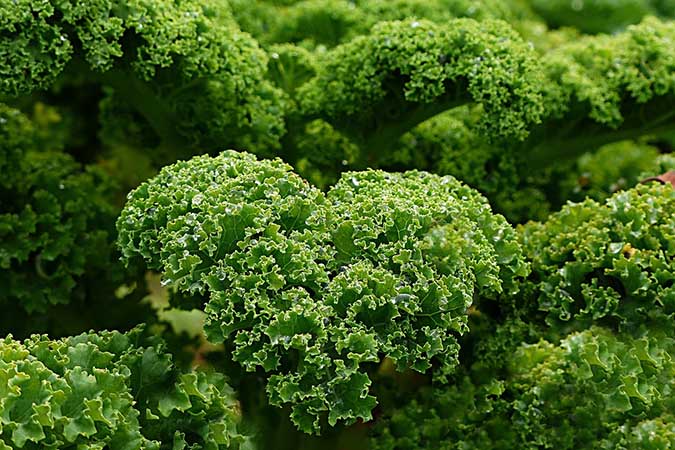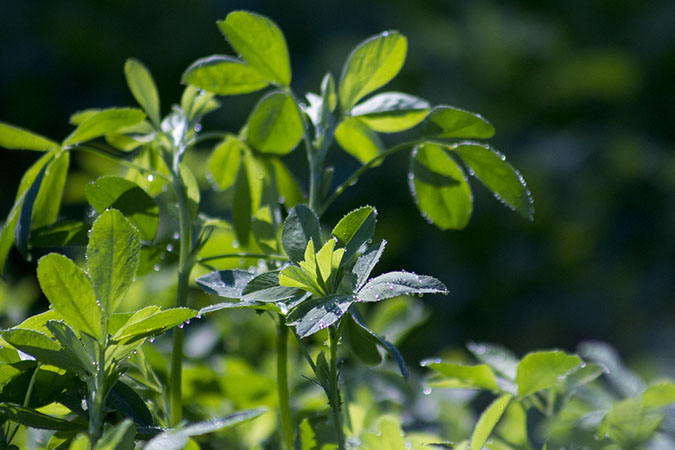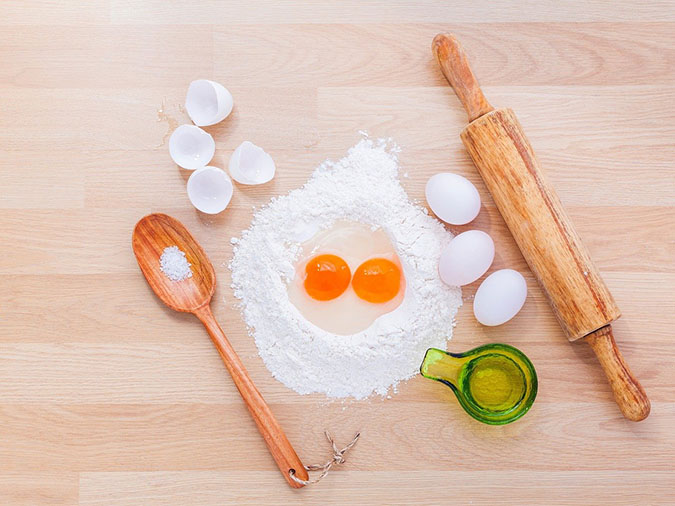Growing Chicken Feed in Your Garden
High-quality chicken feed ain't "cheep"! Grow chicken feed that improves flock health and fits your budget using these smart, simple tips.
How to Grow Chicken Feed (The Easy Way)
In some places, "chicken feed" is an old slang term meaning "cheap." That certainly isn't true today — especially for those of you who feed an organic, soy-free, and corn-free formula to your precious flock. While working for chicken feed may not seem like a good trade-off for you, starting small is the best way to know if growing your own feed is right for you and your flock.
You May Also Enjoy:
"Cheap, Cheep! 4 Novel Ways to Feed Chickens for (Almost) Free"
"The 13 Best Chicken Breeds for Cold Climates"
"5 Excellent Reasons to Keep Backyard Chickens"
This does not mean becoming a grain farmer. Forget about rows of waving grain, harvesting, threshing, and storing. Do it the easy way: Do it one step at a time and set up systems that require minimal labor.
Grow Chicken Feed by Planting Seeds of Change
If you are using cover crops in your garden, you can actually save work and money — just by choosing seed that is chicken friendly.
Many gardeners and homesteaders prefer to keep the flock out of the garden most of the time. But, when winter cover crops are ready to be tilled in (or mowed down for no-till cultivation), the chickens can process that ground for you.
They love doing this work because they eat like little kings and queens! They will also clean up any pests. Any permanent plantings or crops that are still in the ground can be protected from the chickens with row cover or bird netting.
So, while the chickens clean and manure the garden, they are getting fresh grains, legumes, greens, and protein.
You May Also Enjoy:
"No Bare Soil! – Vegetable Garden Cover Crops"
"Does It Make Sense to Grow Grains on Your Homestead?"
"What is the Best Raised Bed Cover Crop for Summertime?"
When planting time comes, just rake the area smooth, add a layer of finished compost , and you are ready to plant. The layer of finished compost covers the raw manure just enough to keep it from splashing up onto the spring crops and keeps any manure just below the top surface where microbes can process it into nutrients for the plants.
When you grow chicken feed like this, the system mimics nature and optimizes the health of your garden ecosystem.
Improving Your Pasture (or Run)
While your chickens are busy preparing the vegetable garden for spring planting, you can grow chicken feed elsewhere by starting another tasty surprise in their pasture or in the greenhouse.
A chicken pasture can be created from any unused lawn area or weedy meadow. If you don't have the extra space to create a chicken pasture, an ordinary chicken run can be improved using these same techniques.
First, cover the area with any organic material you can find — cover all exposed ground with wood chips, hay, spent crops, etc. This layer of organic material keeps bare ground covered and creates a base for recycling manure.
Keeping the surface moist as it breaks down attracts more insects for the chickens to eat, and preserves beneficial microbes and nutrients in the finished compost.
A mulched surface is healthier for the flock, is better to walk on for people tending the chickens, and prevents valuable manure from drying out and blowing away.
Consider, too, that a barren, empty chicken run is a haven for neurotic behavior in the flock. Busy chickens are happy chickens. When you grow chicken feed and there are resulting bugs to catch or prize morsels to scratch up, pecking a hole in a neighbor's head becomes a lot less interesting — it's simple chicken nature.
Grow Chicken Feed a Patch at a Time
Create small patches of seeded forage, protected by a length of fencing that is wired into a circle. Remove the fence when the plants are ready for use as fodder. A height of 4 to 6 inches of growth is optimal for maximum health benefits.
You May Also Enjoy:
"Ferment Your Feed for Healthier and Happier Chickens"
"Using Game Cameras To Protect Your Backyard Chickens"
"Choose the Perfect Chicken Coop: 4 Essential Considerations"
The seed mix you use can be varied according to the season. This system is perfect for small flocks, because the fodder will be consumed before it becomes overly mature. This system is also helpful for those with a large pasture, because you can test different seed before you commit to planting your entire pasture with it — which can be costly.
If your chickens are as silly as mine are, a test before you grow lots of the same chicken feed is always a good idea.
Growing Chicken Feed Indoors
If you have a greenhouse or a cold frame , flats of fresh fodder can be started every two weeks for a steady supply of fresh greens any time of year.
Garden centers have begun to sell small trays of chicken fodder as treats for pampered backyard chickens in urban areas. But if you germinate your own seeds to make starts for the vegetable garden, a chicken smorgasbord is cheap and easy.
You May Also Enjoy:
"Indoor Fodder System: How to Grow Food in Small, Dark Places"
"How to Start Seeds Like a Professional Grower"
"TGN's Favorite Seed-Starting Equipment"
You need seeds, some trays , and some ordinary potting soil or just your own compost. Germinate the seeds and add a mild liquid fertilizer when the fodder reaches about 2 inches tall. At 4 to 6 inches, carry the tray out to the chickens and watch those little rascals party!
Plants for Chicken Runs
If a chicken run is the only space available, grow chicken feed by planting sunflowers along the fence line. Seed for black oilseed sunflowers is inexpensive when purchased in bulk.
Protect the young plants with chicken wire, or plant them on the other side of the fence. When they mature, store the heads and use them to treat the chickens throughout the year. The natural seed heads are feed and container in one!
Sunflowers are the perfect fodder crop where space is limited, because they have such a small footprint. In urban areas, sunflowers are considered attractive even by neighbors who object to the appearance of food crops like corn and squash.
You May Also Enjoy:
"Cold-Weather Chicken Care: 11 Quick Ideas to Improve Chicken Comfort"
"How to Prevent (and Treat) Frostbite in Chickens"
"How to Keep Chicken Water From Freezing"
If you have children to entertain, try planting a sunflower circle with a spiral tail for an entrance in your yard. It makes a wonderfully shady clubhouse during the summer months. When the sunflower heads are harvested and the stalks are cut off at ground level, it completely disappears — though the memories live forever for your little ones.
Include Your Orchard
Homesteaders love to run their chickens through the orchard to collect insects and eat dropped fruit, but what if the orchard was planted with the chickens' arrival in mind?
My orchard is kept heavily mulched and is regularly planted with seasonal crops. When winter greens are spent, the chickens are happy to help with the cleanup. During the hottest part of summer, the orchard becomes a shady place to hunt grasshoppers and gobble up tired bean plants.
You May Also Enjoy:
"How to Grow 21 Amazing Fruit Trees From Seed"
"Planting Fruit Trees in Fall: 11 Tips for Success"
"Planting Fruit Trees from Seed: What About Chill Hours?"
If your orchard is covered with grass, consider planting chicken fodder instead. The diversity will improve the environment for the trees and keep the soil from compacting. Each plant adds a benefit to the soil and the overall ecosystem of the orchard.
I always plant winter squash in the orchard. The large roots of squash travel far and wide, so after the plants are harvested the roots break down and leave organic material available for the fruit trees' roots. The soil's water retention is improved, as well.
The nice, big pumpkins store all winter, so the chickens have access to fresh, living food when there isn't much growing in the pasture. You get all that, just for planting two or three seeds.
Recommended Plants for Chicken Feed

Kale is on the extensive list of crops you can grow for chicken feed. >>> Image by Oldiefan from Pixabay
If you're ready to grow chicken feed for your flock, the following list of plants should help you get started. These plants are chosen because they provide valuable nutrition to the chickens, allowing you to cut down the feed bill. Experiment with other plants that are good for chickens and grow well in your area.
Cover Crops
Red clover
Rye grass
Millet
Alfalfa
Mustard
Daikon radish
Sunflowers

Alfalfa makes a great cover crop and chicken feed. >>> Image by jmklatte from Pixabay
Orchard & Pasture
Red clover
Swiss chard
Rye grass
Millet
Sorghum (Milo)
Alfalfa
Oats
Popcorn
Pumpkin
Flax
Amaranth
Chicory
Beets
Quinoa
Sunflowers
Forage Circles & Seed Flats
Red clover
Swiss chard
Rye grass
Millet
Sorghum
Alfalfa
Oats
Popcorn
Pumpkin
Flax
Amaranth
Nasturtium
Cucumber
Beets
Spinach
Broccoli
Turnip
Mustard
Kale
Quinoa
Daikon radish
Sunflowers
Better Food Equals Better Nutrition

When chickens feast on homegrown feed, their eggs become more nutritious >>> Image by Seksak Kerdkanno from Pixabay
Regular consumption of fresh greens will raise the omega-3 content of eggs and improve the rich orange color of the yolks. That bright color is from the xanthophylls lutein and zeaxanthin. So, the nutritional value of the eggs is greatly enhanced, with higher levels of vitamins A, D, E, and more.
It is easy to see the cascade of benefits that can be realized from getting involved in your chicken's diet. These benefits include reduced feed cost, vastly improved health for the flock, maximized egg quality, conservation of labor in the garden and orchard, and improved diversity of the garden environment.
The start-up commitment for all of these benefits is so small that it is easy to incorporate this into even the smallest garden and the smallest flock. Your chickens might thank you — or they might be way too busy.
What Do You Think?
What's your favorite way to grow chicken feed? Do you have any other tips for success? Share your thoughts in the comments below!
_____________
This is an updated version of an article that was originally published on February 2, 2015. The author, Leslie Parsons, may not currently be available to respond to comments, however we encourage our Community members to chime in to share their experiences and answer questions!
The Grow Network is a participant in the Amazon Services LLC Associates Program, an affiliate program designed to provide a means for our team to earn fees for recommending our favorite products! We may earn a small commission, at no additional cost to you, should you purchase an item after clicking one of our links. Thanks for supporting TGN!
(Visited 40,593 times, 12 visits today)

The Grow Network is a global network of people who produce their own food and medicine. We're the coolest bunch of backyard researchers on Earth! We're constantly sharing, discovering, and working together to test new paths for sustainable living—while reconnecting with the "old ways" that are slipping away in our modern world. We value soil, water, sunlight, simplicity, sustainability, usefulness, and freedom. We strive to produce, prepare, and preserve our own food and medicine, and we hope you do, too!
Source: https://thegrownetwork.com/grow-chicken-feed/
0 Response to "Growing Chicken Feed in Your Garden"
Post a Comment